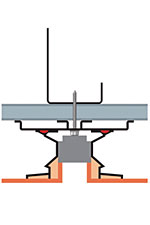Thermal and Moisture Control in Exterior Metal Walls
Custom Wall Systems
Custom wall systems are almost limitless in what can be accomplished.
When comparing the different types of rainscreens, it is important to remember that they serve several important functions. Beyond providing an outward appearance and wearing surface, they allow a wall system to drain liquid and to vent water vapor from external leakage, internal vapor diffusion or internal air leakage. In general, rainscreens allow ventilation behind the metal to help eliminate moisture in the drainage cavity. In a 1988 publication entitled, "Rainscreen Cladding, a Guide to Design Principles and Practice," by Anderson and Gill, two types of rainscreens are defined, backside ventilated, and pressure equalized.
Backside-Ventilated Rainscreens
According to the authors, "back-ventilated...claddings
are allowed to leak, and no deliberate attempt is made to
minimize the effects of wind by means of pressure equalization…large
quantities of rainwater penetrate the joints and run down
the reverse, hidden face of the cladding assembly."
Pressure Equalized
The second type of rainscreen is a pressure-equalized system.
Joseph Lstiburek, Ph.D, P.Eng., principal of the Building
Science Corporation, has studied wall systems in considerable
depth. He describes the most effective wall system as one
that prevents water from entering the wall cavity and wetting
the inner layers, while allowing air to enter and ventilate
the cavity. Proper design of the horizontal joint and the
air barrier in a pressure equalized rainscreen provides what
Lstiburek indicates is excellent performance, that being horizontal
joints that keep water out, while permitting air to enter
and help dry the cavity (Figure 11) . The vertical joints
in this system are continuously rear sealed, creating closed
vertical compartments in the metal cladding that help maintain
pressure equalization (Figure 12). This is critical for high-
wind areas and at the corners of buildings.
|
|












